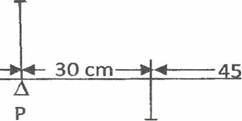This question was reported to being unpopular among the candidates and poorly
attended by majority of those who attempted it.
In part (a), candidates were expected to obtain the resultant of the two forces as
F = (3i + 5j) + (-2; + 3j) = i + 8j. /FI/=√1 + 8² = √6S = 8.06N. The acceleration of the
body is obtained from the relation F = ma where F = 8.06N, m = 2kg.
Therefore a = 8.06 = 4.03 ms–². Change in velocity = a x t = 4.03 x 5 = 20.15ms–².
2
In part (b), candidates were expected to represent the given information
diagrammatically as shown.

Taking moments about P, we have: 15 x 30 = T x 75 => T 15 x 30/75 = 6N. The total
upward force = total downward force. Hence, R + T = 15 i.e R + 6 = 15
=> R = 15 - 6 = 9N.



